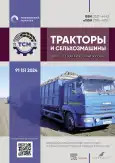Сравнительная экономическая оценка технологических линий приготовления жмыха подсолнечного
- Авторы: Припоров И.Е.1, Курасов В.С.1
-
Учреждения:
- Кубанский государственный аграрный университет имени И.Т. Трубилина
- Выпуск: Том 91, № 5 (2024)
- Страницы: 646-653
- Раздел: Экономика, организация и технология производства
- URL: https://journal-vniispk.ru/0321-4443/article/view/291106
- DOI: https://doi.org/10.17816/0321-4443-626258
- ID: 291106
Цитировать
Полный текст
Аннотация
Обоснование. Важнейшим условием получения продукции животноводства является высококачественная кормовая база. Полная сбалансированность рационов по элементам питания (например, по протеину), гарантирует высокую продуктивность животных и низкие затраты на их производство свыше 75%, что обеспечивает экономическую целесообразность производства комбикормов для сельхозпредприятий. Для их приготовления в фермерских хозяйствах используют комбикормовые заводы типа Р1-БКЗ-5 (Мельинвест). Указанное обстоятельство требует надёжных, простых в эксплуатации и недорогие агрегатов, которые позволяют производить концентрированные смеси из местного сырья. Таким образом, разработка комбикормового агрегата, который позволил бы получать готовый продукт высокого качества при низких удельных затратах и металлоёмкости, является актуальной задачей.
Цель работы — оценка использования технологической линии приготовления концентрированного корма, например, жмыха из семян подсолнечника.
Материалы и методы. Экономическую эффективность разработанных линий для приготовления жмыха по патентам РФ №№ 2646092, 2690882, 2685123, 2694673, 2693741, 2693437, 2694573, 2694722 сравним с комбикормовым агрегатом Р1-БКЗ-5. Методика расчёта приведена в рекомендациях.
Результаты. Для проведения расчёта, предложенных технологических линий для приготовления жмыха, была составлена программа Excel. Приведены исходные данные и результаты расчёта.
Заключение. Предложенные технологические линии для приготовления жмыха подсолнечного являются прибыльными и экономически выгодными по сравнению с серийным агрегатом Р1-БКЗ-5 при использовании мультимедийного устройства и без за счёт снижения прямых эксплуатационных затрат на 24%, а также годовая экономия совокупных затрат составила 91% и срок окупаемости дополнительных капитальных вложений изменяется от 4,59 до 5,27 лет. Разработанные линии включают современные технические средства и оборудование, которые позволяют оценить и повысить качество комбикорма в реальном времени, а также упростить конструкцию, снизить энергоёмкость процесса.
Полный текст
Открыть статью на сайте журналаОб авторах
Игорь Евгеньевич Припоров
Кубанский государственный аграрный университет имени И.Т. Трубилина
Автор, ответственный за переписку.
Email: i.priporov@yandex.ru
ORCID iD: 0000-0002-8201-2819
SPIN-код: 4330-0224
канд. техн. наук, доцент, доцент кафедры «Тракторы, автомобили и техническая механика»
Россия, КраснодарВладимир Станиславович Курасов
Кубанский государственный аграрный университет имени И.Т. Трубилина
Email: i.priporov@yandex.ru
ORCID iD: 0000-0002-1733-9436
SPIN-код: 7925-1853
д-р техн. наук, профессор, заведующий кафедрой «Тракторы, автомобили и техническая механика»
Россия, КраснодарСписок литературы
- Симачкова М.С. Анализ технологических линий и оборудования для приготовления комбикормов // Вестник НГИЭИ. 2023. № 6 (145). С. 18–36. doi: 10.24412/2227-9407-2023-6-18-36
- Фоминых А.В., Фомина С.В., Мялин М.И. Технологическая линия приготовления сухой окары для приготовления комбикормов // Вестник Курганской ГСХА. 2016. № 3 (19). С. 78–80.
- Чупшев А.В. Обоснование перспективной операционной схемы приготовления комбикормов-концентратов в условиях животноводческих предприятий // Нива Поволжья. 2021. № 3 (60). С. 135–141.
- Винницки С., Романюк В., Савиных П.А. и др. Совершенствование технологии кормления высокопродуктивных коров // Вестник Всероссийского научно-исследовательского института механизации животноводства. 2019. № 3 (35). С. 147–151.
- Ромалийский В.С. Инновационная техника и ресурсосберегающие технологии для приготовления комбикормов в хозяйствах // Вестник Всероссийского научно-исследовательского института механизации животноводства. 2016. № 3 (23). С. 158–162.
- Павлидис В.Д., Чкалова М.В., Шахов В.А. Стохастическое моделирование технологического процесса производства комбинированных кормов // Достижения науки и техники АПК. 2022. Т. 36. № 10. С. 78–83. doi: 10.53859/02352451_2022_36_10_78
- Ценч Ю.С. Научно-технический потенциал как главный фактор развития механизации сельского хозяйства // Сельскохозяйственные машины и технологии. 2022. Т. 16, № 2. С. 4–13. doi: 10.22314/2073-7599-2022-16-2-4-13
- Брагинец С.В., Бахчевников О.Н. Сравнительная технико-экономическая оценка малых внутрихозяйственных комбикормовых предприятий // Агроинженерия. 2021. № 5(105). С. 59–65. doi: 10.26897/2687-1149-2021-5-59-65
- Анисимов А.В. Перспективы глубокой переработки зерна на малых предприятиях // Аграрный научный журнал. 2019. № 2. С. 61–65. doi: 10.28983/asj.y2019i2pp61-65
- Савиных П.А., Сычугов Ю.В., Казаков В.А. и др. Комбикормовый цех для сельскохозяйственного предприятия // Вестник Курской государственной сельскохозяйственной академии. 2018. № 6. С. 131–137.
- Методика определения экономической эффективности технологий сельскохозяйственной техники. В 2-х ч. М.: Министерство сельского хозяйства и продовольствия РФ, 1998.
- Baldea M., Edgar T.F., Stanley B.L. et al. Modular manufacturing processes: Status, challenges, and opportunities // AIChE Journal. 2017. №63 (10). P. 4262–4272. doi: 10.1002/aic.15872
- Герасимова С.П., Зырянов Д.А., Турубанов Н.В., и др. Технико-экономическое обоснование внутрихозяйственного комбикормового цеха // Владимирский земледелец. 2018. № 4. С. 58–63. doi: 10.24411/2225-2584-2018-10044
Дополнительные файлы









